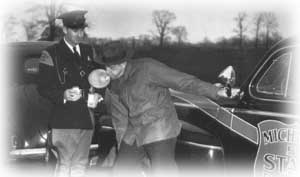|
|
Jacob Sullum
AFTER I'VE HAD three pints of beer in an hour, I'm pretty tipsy. But the Drink Wheel, a computer program available
at www.intox.com, says my blood alcohol concentration is well below .08 percent.
That's the legal limit for driving in 15 states, the standard that a bill recently approved by the Senate aims to
impose on the whole country. The American Beverage Institute, which represents restaurateurs and other
opponents of the bill, has argued that a .08 limit would cover a lot of social drinkers who are basically OK to
drive. My encounter with the Drink Wheel suggests otherwise.
Granted, tolerance for alcohol varies from person to person, and it's risky to extrapolate from a sample of one.
But the National Highway Traffic Safety Administration reports that attention, speed control, braking, steering,
gear changing, lane tracking and judgment are all measurably impaired at a BAC of .08.
It seems fair to say that a reasonably cautious person would not fully trust his driving ability at this level of
To begin with, the Constitution leaves such matters to the states. That's why the BAC bill's sponsors, instead of
simply legislating a national limit, are threatening to withhold highway funds from states that do not adopt a .08
standard. This maneuver, which was also used to establish a de facto national drinking age of 21, is an end run
around the 10th Amendment.
Constitutional concerns aside, a lower BAC limit would be a waste of law-enforcement resources if it failed to
reduce crashes. The ABI notes that a .10 standard, used by 33 states and Washington, D.C., applies in eight of
the 10 states with the lowest rates of alcohol-related traffic fatalities, and those rates are no higher in the United
States than in 16 industrialized countries with lower BAC limits.
Mothers Against Drunk Driving, the main group pushing a national standard, cites a 1996 American Journal of
Public Health study that compared traffic deaths in five states that switched to the .08 limit with traffic deaths in
five other states. Overall, the study found a 16 percent reduction in crashes that killed drivers with BACs of .08
or more.
In a before-and-after study like this one, it's impossible to separate the effect of the limit itself from the impact of
factors such as publicity, new penalty procedures and more-aggressive enforcement. Furthermore, the 16
percent figure was based on a pooling of data that made the results seem stronger than they really were.
Only two of the states (California and Oregon) saw statistically significant drops in fatalities, while a third (Utah)
saw an increase significantly lower than the increase in a comparison state. An ABI-commissioned analysis by
Data Nexus Inc. found that the advantages for California and Utah disappeared when different comparison
states were used.
Another reason to be skeptical: Drivers with BACs between .08 and .10 are involved in just 6 percent of
alcohol-related traffic fatalities, according to NHTSA data. And it's important to remember, especially when
dealing with relatively low BACs, that crashes are considered "alcohol-related" if a driver has consumed a
detectable amount, whether or not it contributed to the accident.
More than three-quarters of the drivers in such accidents have BACs of .10 or more, with 62 percent above .14.
The average BAC for fatally injured drunk drivers is a whopping .18 percent.
This pattern raises issues of fairness as well as efficiency. The driver who's just had three pints of beer may be
negligent, but he's not nearly as reckless as the one who drank half a bottle of whiskey. Should the law treat
them the same?
Blurring such distinctions paves the way for a ban on driving after any amount of drinking. MADD says "nearly
one quarter (3,732) of the 17,126 alcohol-related traffic deaths in 1996 involved drivers with BAC levels below
.10," and "MADD thinks that's a problem worth solving." But three-quarters of those 3,732 fatalities involved
drivers with BACs below .08. So why stop there?
Steve Simon, chairman of the Minnesota DWI Task Force, says ".05 is better. That's where we're headed. It
doesn't mean we should get there all at once. But ultimately it should be .02." Under that standard, it would be
illegal to drive home after drinking a beer. MADD insists it won't go that far. But its logic
 BAC Scratching
BAC Scratching
 intoxication. But that's not a sufficient basis for a federal law.
intoxication. But that's not a sufficient basis for a federal law.
03/5/98: Felonious Speech
02/20/98: Rules of the game
02/13/98: Feeling his pain... and a little pleasure